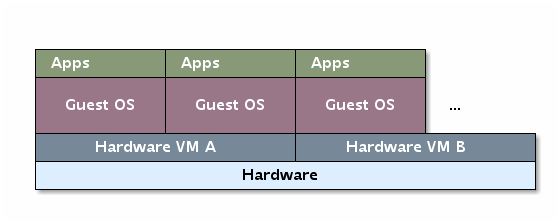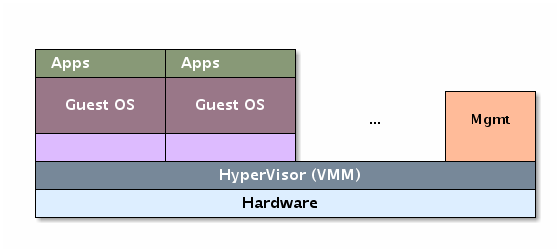Virtualization – an Overview
This page covers the efforts to integrate various virtualization technologies into Fedora.
Introduction
Virtualization allows one to run many guest virtual machines on top of a host operating system such as Fedora. What this means is that using one computer, you can mimic several individual computers and even run different operating systems in each of these virtual machines. There are many different virtualization technologies, including both free and open source software and proprietary offerings. A good article on IBM DeveloperWorks (M Tim Jones, Dec 2006, archived) Web site illustrates the four main different virtualization families, namely
-
hardware emulation
-
hardware-assisted full virtualization
-
para-virtualization (PV)
-
operating system-level virtualization (containers/zones)
Hardware-assisted full virtualization

Full virtualization uses a hypervisor (a.k.a. VMM, standing for Virtual Machine Monitor) to share the underlying hardware. A few implementations:
-
Xen is a virtual-machine monitor providing services that allow multiple computer operating systems to execute on the same computer hardware concurrently. Xen has been the solution of choice for RedHat EL distributions since 2005. The kernel-2.6.18 dropped support for Xen, but the necessary modules/modifications have been added to the upstream kernel again, from 2.6.37 for DomU (guests) and from 3.0 for Dom0 (base domain, part of the host). Therefore, Xen Dom0 host support, that was dropped after Fedora 8, it has now been re-introduced, from Fedora 16.
-
VirtualBox is a full virtualization solution for x86 and AMD64/Intel64 hardware. Sun Microsystems started that project, which is now fully supported by Oracle. There is a dual licencing scheme, among which GPLv2. Allegedly VirtualBox is one of the fastest full virtualization solutions.
Operating system-level virtualization

Operating system-level virtualization partitions a host into insulated guests, which are therefore as kinds of chroot, but with much stronger resource isolation.
Originally, this family of virtualization was referred to as zones and evolved into highly sophisticated containers today.
A few implementations:
-
Docker isolate a single process in its own environment
-
Linux-VServer, which does not seem to be no longer active (the last news is dated back in 2009)
Fedora Support
A number of third parties (e.g., RPMFusion) provide add-on packages for other virtualization technologies: OpenVZ, Linux-VServer, VirtualBox.
Anticipating this diversification of technology, since the days of Fedora Core 5, all core management applications have been built on top of the libvirt toolkit, which offers a technology independent API for managing virtual systems.
Clouds
As Cloud-based infrastructures rely, by nature, on virtualization technologies, both subjects are therefore heavily inter-related. The Fedora Cloud Edition is dedicated to the subject, worth to follow as well.
History
Fedora Core 5 was the first release to include Xen as a core integrated technology. The new Linux native virtualiation, KVM, was introduced to Fedora 7. For a more detailed account of virtualization progress in Fedora, consult the Virtualization History page.
News
There is semi-regular coverage of Virtualization news in various Fedora communication media, specifically in Fedora Magazine, Fedora Community Blog, and Fedora Discussion, #libvirt
Getting started
The Quick Docs article Virtualization – Getting Started provides an excellent overview to using the virtualization capabilities in Fedora.
Specifically for Fedora Server Edition there is extensive and step-by-step guidance available.
Various magazine articles on virtualization have introductory material as well.
Bugs
See Virtualization – How to Debug Issues for some tips on reporting virtualization bugs to bugzilla.
oVirt
oVirt is a Fedora based project which provides small host images and a web-based virtual machine management console. See their website to learn more and get involved.
Want to help? Learn how to contribute to Fedora Docs ›

